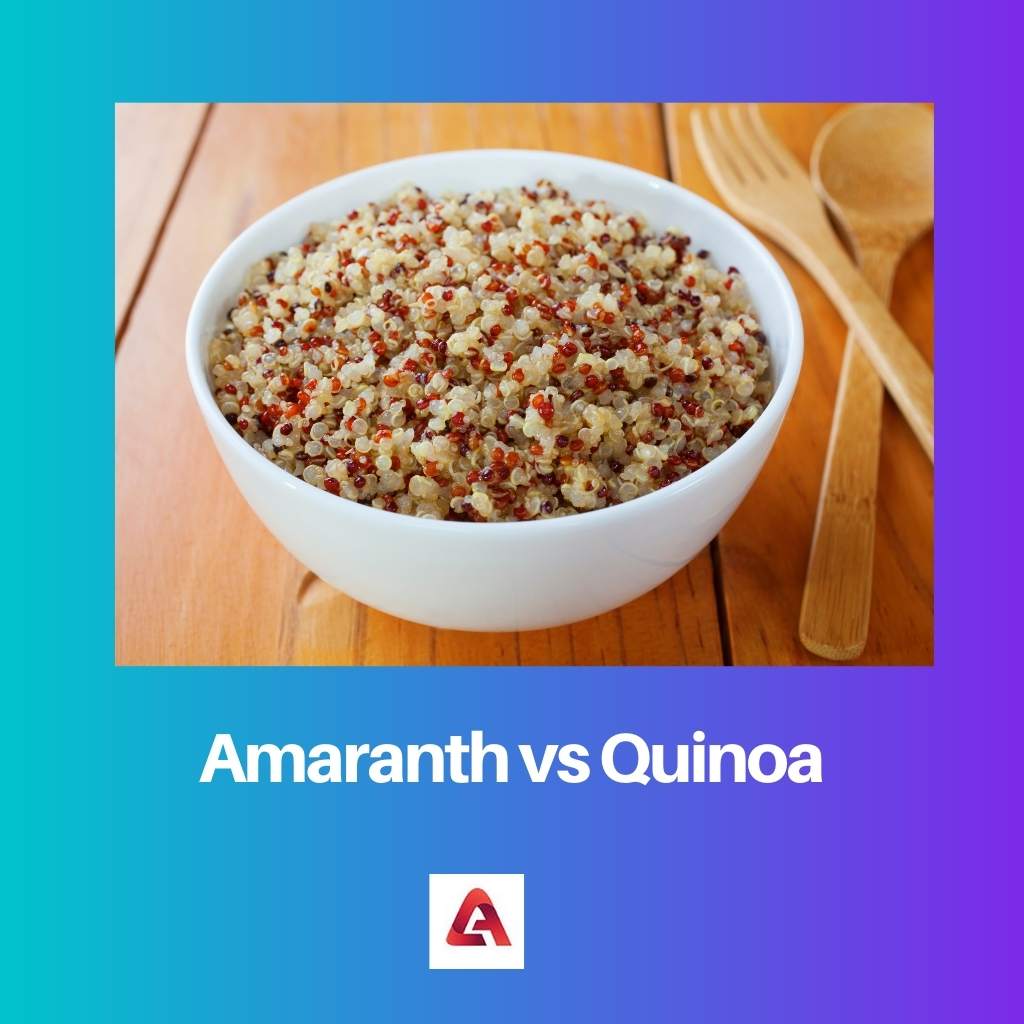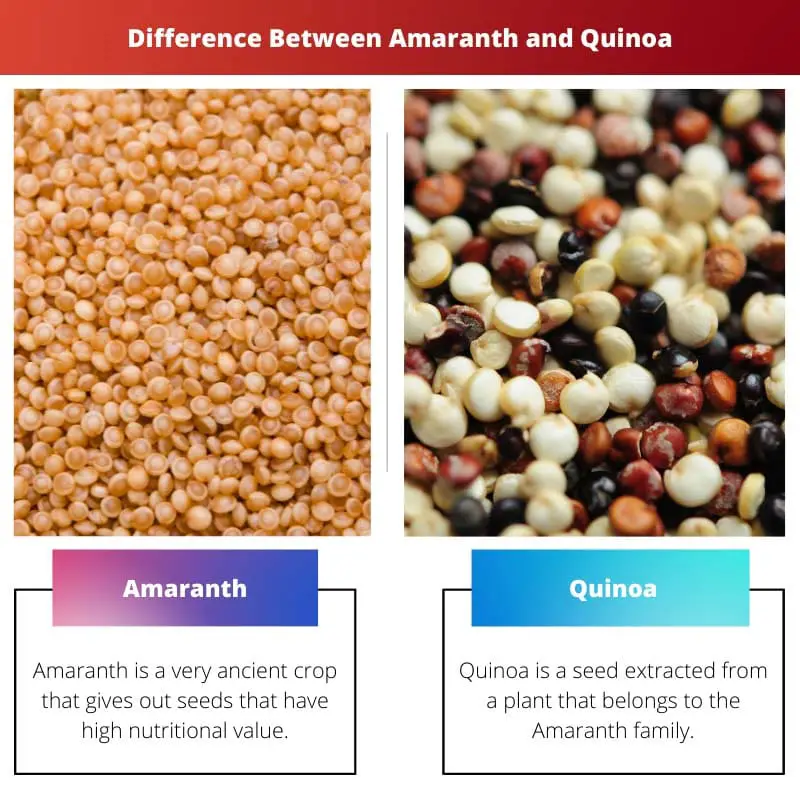Shedding weight without losing nutrients from the human body is always preferred. A healthy diet is considered to be the best and even suggested by physicians.
Key Takeaways
- Amaranth contains more amino acid lysine than quinoa, making it a complete protein source.
- Quinoa outperforms amaranth in fiber content, providing a greater feeling of fullness and promoting healthy digestion.
- Amaranth grows well in various climates, including drought-prone areas, whereas quinoa requires specific conditions, making amaranth more versatile for cultivation.
Amaranth vs Quinoa
Amaranth refers to a plant species belonging to the Amaranthaceae family and has been cultivated for thousands of years. Quinoa (pronounced KEEN-wah) is a gluten-free pseudo-grain that comes from the flowering plant Chenopodium quinoa, which is native to the Andean region of South America.

Amaranth is an impressive health food that is suggested for dieting purposes. It is a grain that is consumed as a staple food in certain parts of the world.
Quinoa, on the other hand, is from the Amaranth family. Ideally, a flowering plant that gives out highly nutritious seeds. The nutritional world considers Quinoa as a whole grain.
Comparison Table
| Parameters of Comparison | Amaranth | Quinoa |
|---|---|---|
| Plantation | Amaranth is planted during June every year. | Quinoa is a planter during April or May every year. |
| Protein Level | Amaranth has high protein levels. | Quinoa has lower protein levels compared to Amaranth. |
| Protection Methods | Amaranth seeds are not coated with any substance, and they can stand in your kitchen for a long time. | Quinoa is affected by insects, so artificially, it is coated with saponin. |
| Iron Level | Iron levels are high. | Iron levels are low |
| Usage | Used in soups and also in casseroles. | Ideally used in salads and fried dishes. |
What is Amaranth?
Amaranth is a very ancient crop that gives out highly nutritious seeds. It is a native of South America and is also consumed as a staple food in many parts of the world.
Amaranth is highly rich in protein, iron, and fibre. It is used in many dishes and, in recent times, considered a healthy diet food item.
There are many benefits of Amaranth.
- Consuming the grain shall reduce cholesterol levels in the body.
- If you are suffering from gluten intolerance or celiac disease, Amaranth is the best medicine to consume
- Amaranth also helps in building muscles. It is essentially due to the presence of amino acids.
The grain is also filled with needed minerals like calcium, magnesium, potassium, and phosphorus. This helps in strengthening the bones.
The more prevalent emotional problem is hypertension. Amaranth is the best solution for the same. The good news is Amaranth has good taste.
[amazon bestseller=”Amaranth” items=”2″ template=”table”]

What is Quinoa?
Quinoa is a seed extracted from a plant that belongs to the Amaranth family. The seed is considered to be whole grain because of the method of consumption.
Quinoa is a perfectly healthy diet with all the essential amino acids. The size of the grain is slightly larger than the Amaranth.
The benefits of consuming Quinoa are mentioned below
- Alpha-linolenic acid that is present in the seeds helps in maintaining the health of the heart.
- If you are planning to reduce extra weight, this is a good substitute for many food items
- Quinoa helps in reducing sugar levels, too, this is mainly because the grain has a very low glycemic index.
If you are planning to look young, Quinoa is the best edible product the earth can offer you. The antioxidants that are present in the grain fight free radicals aggressively.
[amazon bestseller=”Quinoa” items=”2″ template=”table”]

Main Differences Between Amaranth and Quinoa
- The protein content is also high in Amaranth, while Quinoa has less amount of protein in it.
- Amaranth and Quinoa help fight diabetes, so Amaranth is used in curries, soups and the like, while Quinoa is predominantly a salad dish while it is also used in fried items.

The detailed comparison of Amaranth and Quinoa has been incredibly informative. The clear distinction between their nutritional content and health benefits has been presented effectively. Further discussions on their applications in various culinary recipes and meal preparations would enhance the understanding of their versatility and usefulness in diverse food cultures.
Absolutely, further insights into the diverse culinary applications of Amaranth and Quinoa across different cuisines and dishes would offer an engaging and fascinating exploration of their adaptability and unique nutritional profile.
I couldn’t agree more. Exploring the application of Amaranth and Quinoa in different culinary traditions and regional cuisines would certainly provide an enriching perspective on their role in varied global food cultures and meal preparations.
Your thoughts on the benefits and nutritional aspects of Amaranth and Quinoa seem to reflect the scientific studies you’ve cited. However, the nutritional benefits of any food are contingent on the health status and dietary preferences of an individual. It would be helpful to discuss their nutritional content in the context of a balanced diet. Additionally, there is substantial evidence suggesting that varied diets can be beneficial, and as such, could you illustrate how Amaranth and Quinoa, when considered together, can contribute to a varied and balanced diet?
Absolutely, the emphasis on how these foods can contribute to an overall healthy diet pattern is extremely important. A balanced diet is critical to ensuring that the nutrients from these foods can be effectively utilized. I’d be interested in hearing more on how these foods can be combined with other nutrient-rich foods to achieve a well-rounded diet.
That’s an excellent point. A holistic approach to diet should be the definitive goal when considering the health consequences of different foods.
The detailed comparison between Amaranth and Quinoa has provided a comprehensive understanding of their nutritional attributes. A fascinating addition could be exploring the compatibility of these grains with different dietary preferences, including vegetarian, vegan, and gluten-free diets. Understanding their adaptability to diverse dietary patterns would be enlightening.
Indeed, discussing their adaptability to different dietary preferences, including vegetarian and gluten-free diets, would provide an enriching and comprehensive understanding of their potential to cater to diverse nutritional needs.
Absolutely, considering their compatibility with various dietary preferences and requirements, particularly those of vegetarians, vegans, and individuals with gluten intolerance, would certainly offer valuable insights into their versatility and application in diverse dietary practices.
The profound nutritional attributes of Amaranth and Quinoa are impressive. Given the remarkable health benefits of these foods, it would be beneficial to explore their use in modern cooking methods and innovative culinary applications. This could lead to widespread acceptance and integration of these nutrient-rich grains into mainstream dietary practices.
Indeed, understanding their potential uses in modern cooking and innovative culinary practices will showcase the versatility and adaptability of Amaranth and Quinoa. An exploration of their incorporation into contemporary meals will undoubtedly contribute to their inclusion in diverse dietary patterns.
Absolutely, emphasizing their application in modern cooking and novel culinary practices would provide innovative and creative ways of including these foods in contemporary dietary patterns and food culture.
This comparison has provided a comprehensive insight into two popular health foods. It’s evident that both Amaranth and Quinoa offer essential nutrients that can contribute to a healthy diet. The table view and accessible explanations have made it easier to understand their differences. The content is both engaging and educational.
The nutritional comparison of Amaranth and Quinoa has been exceptionally insightful. Building on this insightful analysis, it would be illuminating to discuss their culinary and dietary applications in traditional and contemporary cuisines around the world. Understanding their place in diverse global food cultures would provide a comprehensive outlook on their significance in modern dietary practices.
Absolutely, delving into the culinary and dietary applications of Amaranth and Quinoa in traditional and contemporary global cuisines will add an enriching perspective on their role in diverse food cultures, and their potential to contribute to the nutritional well-being of a wide range of populations.
This article provides an insightful nutritional analysis and comparison of Amaranth and Quinoa. The emphasis on the essential nutrients such as protein, iron, fibre, and amino acids provides a holistic understanding of their respective benefits. Additionally, it would be valuable to explore the environmental and sustainability aspects of cultivating and consuming these grains, including considerations for food security and climate sustainability.
Certainly, highlighting the environmental aspects and the sustainability of these crops will provide a more comprehensive perspective on the impact of their cultivation and consumption, especially concerning global food security and agricultural practices.
Absolutely, discussing the environmental and sustainability factors related to the cultivation and consumption of Amaranth and Quinoa would contribute to the broader understanding of their significance in the context of global agriculture and food systems.
The nutritional benefits of Amaranth and Quinoa are fascinating. The health implications of consuming these superfoods are substantial. It would be insightful to include how these foods can be incorporated into popular culinary dishes from various cultures, thereby achieving both nutritious and culturally diverse meals that would benefit a wide range of people.
A wonderful idea! Understanding the different methods of incorporating these highly nutritious grains into versatile dishes across different cultures would indeed provide a global perspective on the multifaceted uses and advantages of these foods.
It’s evident that Amaranth and Quinoa offer distinct nutritional benefits. Given the growing emphasis on alternative and nutrient-dense diets, it would be beneficial to explore how these grains can be incorporated into everyday meals and snack options, thereby promoting a healthy and diverse dietary pattern for diverse populations.
Absolutely, discussing the incorporation of Amaranth and Quinoa into daily dietary practices, along with exploring their potential as snack options and versatile meal additions, can offer valuable insights into creating exciting and nutritious dietary patterns, especially for individuals seeking alternatives to traditional dietary staples.
The remarkable nutritional content and health benefits of Amaranth and Quinoa have been presented in great detail. It would be enriching to include insights into their potential for addressing global nutritional challenges, such as malnutrition and food insecurity, especially in regions with limited resources. Understanding their impact on enhancing nutritional well-being would be of significant interest.
Indeed, exploring the utilization of Amaranth and Quinoa in addressing global nutritional challenges, including malnutrition and food insecurity, would provide valuable insights into their potential to enhance nutritional outcomes and support global food security.
Absolutely, considering the potential of Amaranth and Quinoa in addressing global nutritional challenges and food insecurity, particularly in regions with limited resources, would present a holistic understanding of their significance in promoting nutritional well-being and alleviating malnutrition.